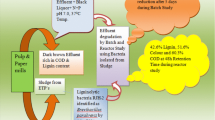Abstract
A pentachlorophenol (PCP) degrading bacterium was isolated and characterized from sludge of pulp and paper mill. This isolate used PCP as its sole source of carbon and energy and was capable of degrading this compound, as indicated by stoichiometric release of chloride and biomass formation. Based on morphology, biochemical tests, and 16S rRNA gene sequence analysis this strain was identified as Kocuria sp. CL2. High Performance Liquid Chromatography (HPLC) analysis revealed that this strain was able to degrade PCP up to a concentration of 600 mg/l. This is first time we are reporting the degradation of PCP by the Kocuria species. This isolate was also able to remove 58.64% of PCP from the sludge within two weeks. This study showed that the removal efficiency of PCP by CL2 was found to be very effective and can be used in degradation of PCP containing pulp paper mill waste in the environment.






Similar content being viewed by others
References
Annachhatre AP, Gheewala SH (1996) Biodegradation of chlorinated phenolic compounds. Biotechnol Adv 14:35–56
Apajalahti J, Karpanoja P, Salkinoja-Salonen MS (1986) Rhodococcus chlorophenolicus new-species a chlorophenol mineralizing actinomycete. Int J Syst Bacteriol 36:246–251
Bock C, Kroppenstedt RM, Schmidt U, Diekmann H (1996) Degradation of prochloraz and 2,4,6-trichlorophenol by environmental bacterial strains. Appl Microbiol Biotechnol 45:257–262
Chandra R, Ghosh A, Jain RK, Singh S (2006) Isolation and characterization of two potential pentachlorophenol degrading aerobic bacteria from pulp paper effluent sludge. J Gen Appl Microbiol 52:125–130
Dams RI, Paton GI, Killham K (2007) Rhizomediation of pentachlorophenol by Sphingobium chlorophenolicum ATCC 39723. Chemosphere 68:864–870
Gonzalez JF, Hu WS (1991) Effect of glutamate on the degradation of pentachlorophenol by Flavobacterium sp. Appl Microbiol Biotechnol 35:100–104
Holt JG, Krieg NR, Sneath PHA, Staley JT, Williams ST (1994) Bergey’s manual of determinative bacteriology, 9th edn. Williams and Wilkins, Baltimore, pp 626–640
Homada MF, Haddad AI, Abd-El-Bary MF (1987) Treatment of phenolic wastes in an aerated submerged fixed-film (ASFF) bioreactor. J Biotechnol 5:279–292
Kaoa CM, Liu JK, Chen YL, Chai CT, Chen SC (2005) Factors affecting the biodegradation of PCP by Pseudomonas mendocina NSYSU chloride release. J Hazard Mater 124:68–73
Kapley A, Lampel K, Purohit HJ (2001) Rapid detection of Salmonella in water samples by multiplex PCR. Water Environ Res 73:461–465
Laine MM, Jorgensen KS (1997) Effective and safe composting of chlorophenol-contaminated soil in pilot scale. Environ Sci Technol 31:371–378
Miethling R, Karlson U (1996) Accelerated mineralization of pentachlorophenol in soil upon inoculation with Mycobacterium chlorophenolicum PCP1 and Sphingomonas chlorophenolica RA2. Appl Environ Microbiol 62:4361–4366
Mohn WW, Kennedy KJ (1992) Reductive dehalogenation of chlorophenol by Desulfomonite tiedjei DCB-1. Appl Environ Microbiol 58:1367–1370
Radehaus PM, Schmidt SK (1992) Characterization of a novel Pseudomonas sp. that mineralizes high-concentrations of pentachlorophenol. Appl Environ Microbiol 58:2879–2885
Reddy SNG, Prakash SSJ, Prabahar V, Matsumoto GI, Stackebrandt E, Shivaji S (2003) Kocuria polaris sp. nov., an orange-pigmented psychrophilic bacterium isolated from an Antarctic cyanobacterial mat sample. Int J Syst Evol Microbiol 53:183–187
Reineke W, Knackmuss HJ (1988) Microbial degradation of haloaromatics. Annu Rev Microbiol 42:263–287
Saber DL, Crawford RL (1985) Isolation and characterization of Flavobacterium strain that degrade pentachlorophenol. Appl Environ Microbiol 50:1512–1518
Sai K, Kang KS, Hirose A, Hasegawa R, Trosko JE, Inoue T (2001) Inhibition of apoptosis by pentachlorophenol by v-myc-transfected rat liver epithelial cells: relation to down-regulation of gap junctional intercellular communication. Cancer Lett 173:163–174
Solyanikova IP, Golovleva LA (2004) Bacterial degradation of chlorophenols: pathways, biochemica, and genetic aspects. J Environ Sci Health B 39:333–351
Tamura K, Dudley J, Nei M, Kumar S (2007) MEGA4: Molecular Evolutionary Genetics Analysis (MEGA) software version 4.0. Mol Biol Evol 24:1596–1599
Vallecillo A, Garcia-Encina PA, Pena M (1999) Anaerobic biodegradability and toxicity of chlorophenols. Water Sci Technol 40:161–168
Weisburg WG, Barns SM, Pelletier DA, Lane DJ (1991) 16S ribosomal DNA amplification for phylogenetic study. J Bacteriol 173:697–703
Wittmann C, Zeng AP, Deckwer WD (1998) Physiological characterization and cultivation strategies of the pentachlorophenol degrading bacteria Sphingomonas chlorophenolica RA2 and Mycobacterium chlorophenolicum PCP-1. J Ind Microbiol Biotechnol 21:315–321
Yang CF, Lee CM, Wang CC (2006) Isolation and physiological characterization of the pentachlorophenol degrading bacterium Sphingomonas chlorophenolica. Chemosphere 62:709–714
Acknowledgements
The authors are thankful to TIFAC-CORE in Agro and Industrial Biotechnology, Thapar University for providing facilities.
Author information
Authors and Affiliations
Corresponding author
Rights and permissions
About this article
Cite this article
Karn, S.K., Chakrabarti, S.K. & Reddy, M.S. Degradation of pentachlorophenol by Kocuria sp. CL2 isolated from secondary sludge of pulp and paper mill. Biodegradation 22, 63–69 (2011). https://doi.org/10.1007/s10532-010-9376-6
Received:
Accepted:
Published:
Issue Date:
DOI: https://doi.org/10.1007/s10532-010-9376-6




